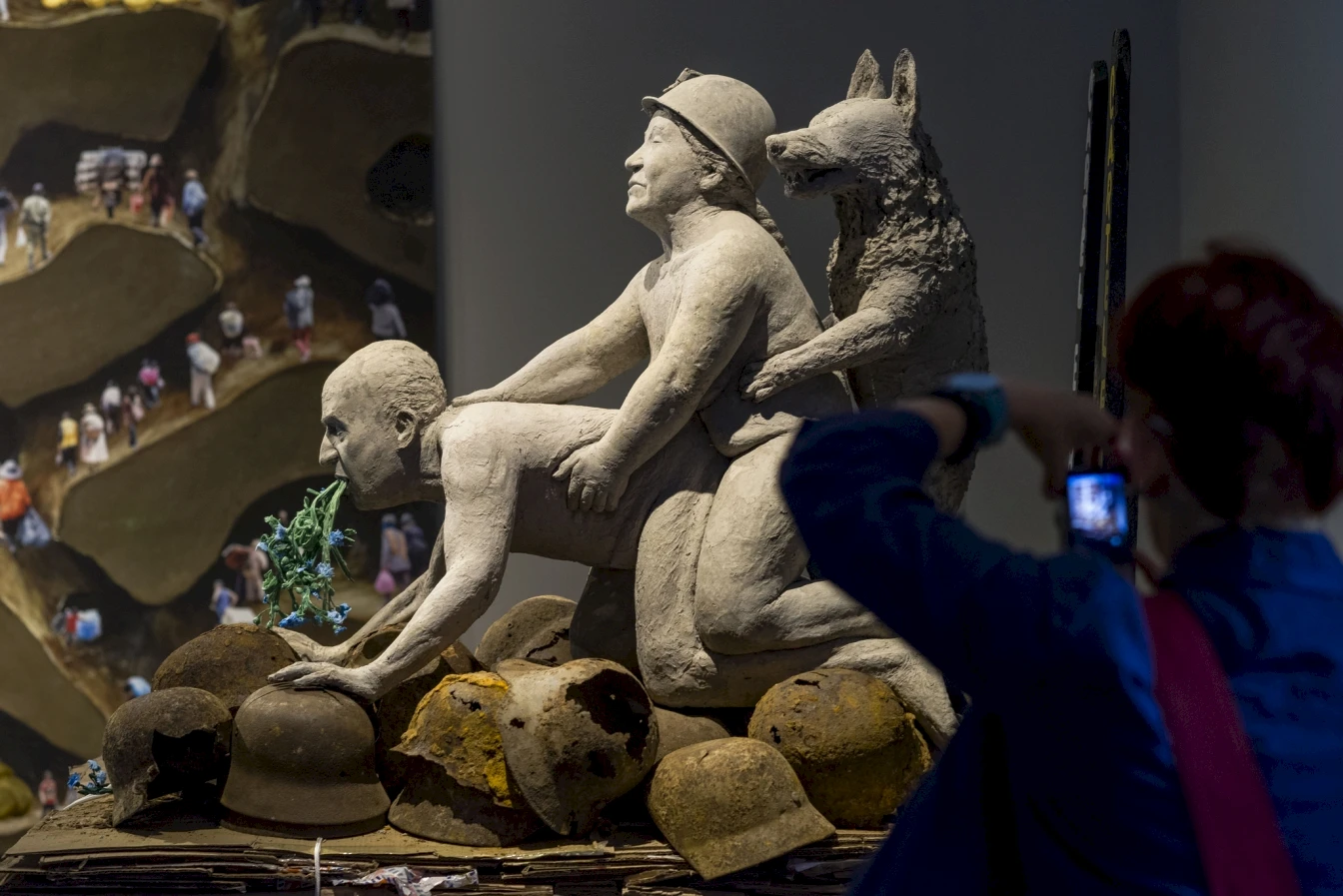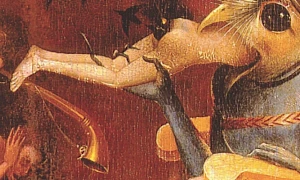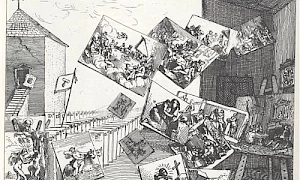A Misunderstanding: Ines Doujak's Not Dressed for Conquering / HC 04 Transport and Differences of Scale

Ines Doujak and John Barker, Obra Loomshuttles, Warpaths, 2010-2018. A visitor taking a picture of the work during the press review of the 31st São Paulo Biennial, 1.9.2014. © Leo Eloy / Fundação Bienal de São Paulo.
1During the 31st edition of the Bienal de São Paulo in 2014, for which I was part of the curatorial team,2 Ines Doujak's sculpture Not Dressed for Conquering / HC 04 Transport (2014) was deemed potentially inappropriate for visitors under 18 by an education official from the State of São Paulo. The assessment came in the form of a verbal report given to the Fundação Bienal team. This took place during an inspection following a campaign by a Catholic group3 who considered parts of the exhibition blasphemous and/or morally wrong, and a large number of complaints to the Bienal. Because it was not written, the assessment came without official instructions on how to proceed; the Fundação Bienal took the decision, with the tacit agreement of the curatorial team, to build a new wall a few weeks after the opening of the exhibition (a move that is both extremely unusual and technically risky, when artworks are already installed in the space). This wall would keep the sculpture out of sight from those inadvertently walking around the exhibition by creating a separate entrance to view the sculpture accompanied by a sign specifying its 'potentially inappropriate' nature.
In fact, the sign itself was already there on the opening day, close to the sculpture, announcing its content in a way that didn't allow for a decision from the visitors on whether he or she should actually see it – the sign and the sculpture appeared simultaneously or, rather, the sculpture presented itself without barriers, assertively, turning the sign on the wall into an afterthought. As curators, we had accepted from the start, prompted by the permanent team of the Bienal and without giving it a lot of thought (not enough thought, I would say), that the sculpture could be different from other artworks – that it could, somehow, have a stronger effect on some of the viewers.
The inappropriate character of something is a polemical thing to ascertain, and perhaps that's why it always appears either in the hands of an authority – who is entitled to make the judgement – or accompanied by a potentiality – a 'could be'. In a city that is not yours, or only recently so, in an institution where you have never worked before, and with publics you haven't ever encountered (as happens in many biennials), determining what might be appropriate is, to say the least, delicate. To make things more complicated, the context of contemporary art is dominated by a Western discourse that dismisses inappropriateness as nonsensical: art is not (cannot be) but improper. In contrast to this 'absolute' demand, which arrogantly tries to impose itself in 'any' context, in the realm of education, a concern at the core of the 31st Bienal, being proper is perhaps not a matter of principle but of detail: the suitability, or the need, for a certain element, attitude or process depends on the conjuncture where that element, attitude or process is to intervene.
Whether seen as an artwork or a pedagogical tool (or both), in the 31st Bienal Ines Doujak's Not Dressed for Conquering / HC 04 Transport was deemed potentially improper, and done so according to a logic that was not made explicit, neither by the State of São Paulo's official, nor the Fundação Bienal or the curatorial team. But if one logic can be deduced from the decision process that took place, it was a logic of effects – of the effects that a specific element of the sculpture might have on some of the people who would encounter it: not the sculpture's political allegories, but the sexual act that the contiguity of three naked bodies might suggest. Or, better, not a simple sexual act, but a sexual act between three, rather than two, bodies; between two human and one animal body; between three bodies that, because of their relative positions, could be (but are they really?) engaged in anal sex. The point that no genitalia appear in the sculpture seemed irrelevant to that logic – the judgement was based on the possibility of a very specific, limited reading.
In Davi Kopenawa and Bruce Albert's A queda do céu, Albert talks about three basic imperatives required for an anthropologist who intends to engage with an indigenous people: the first is to do scrupulous justice to the conceptual imagination of his or her hosts; second, to take into account with all possible rigour the local and global socio-political context with which their society is confronted; and last, to keep a critical eye on the framework of the ethnographic research.4 If, as curators of the 31st edition of the Bienal we were to adopt these demands, thinking of the curatorial operation as one of mediation of a specific culture in relation to context, the conclusion would be damming: none of the three imperatives were fulfilled. The framework, this time curatorial rather than anthropological, was treated lightly (by privileging, without much thought, the curators' responsibility to the institution and its demands rather than to the artist and her work); the contextual considerations were resolved considering just one variable (the potential harmful effects for the exhibition and the Fundação of contravening a recommendation from the state, who financially supports its activities); and the logic of the work. Here, the logic of the work vanished, undone by a misunderstanding that seems to have followed this sculpture wherever it's been shown subsequently, and perhaps before it arrived in Brazil.
This misunderstanding is, simply, the act of privileging the curatorial and institutional frameworks as the location where meaning is enunciated and articulated in contemporary art. Perhaps this is a curatorial habit (a professional 'class' interest made into a universal concern), perhaps it is a response solicited by the historical privilege assigned to the artist-author as framework, possibly there are other forces at play. Yet what results is an attitude that Not Dressed for Conquering / HC 04 Transport's trajectory neatly reveals: an ongoing, persistent inability or unwillingness of those involved and with the power to intervene publicly (curators, institution, critics...) to consider the scale of the work as being of equivalent importance to the scale of the exhibition and to the scale of the institutional apparatus that exhibits it. With just two exceptions,5 what was written about the piece and the way it was treated makes it an emblem, a function, an example, a Trojan horse or an illustration of battles that are being fought elsewhere. The battle of censorship (a war of neat opposites in which everyone is expected to declare their being on the right side), a battle for a specific institutional model (within a dying, perhaps already dead, European system of funding or administration of culture), a battle of morality (in the midst of a tense negotiation about social values in Brazil), and battles among individuals for specific positions of power of enunciation (perhaps too many, too delicate to list in passing). There are possibly, certainly, other battles, and all of them seem to have put Not Dressed for Conquering / HC 04 Transport at their service. Throughout these battles the sculpture has persisted when other things and people have fallen, but it has done so as a ghostly presence, with little agency of its own.
Such subsumption, however, is not the only possibility. In fact, the instrumental impulse that drives this move demands a simplification that it refuses to acknowledge. As Marilyn Strathern proposes in Partial Connections,6 different scales of approach (in our case, for example, the work, the exhibition, institutional framework or cultural politics at large) are incommensurable and of equal complexity; consequently, if a reading seeks to do justice to that complexity, it needs to articulate itself across different scales, embracing its distances and clashes as a need and a virtue. That being the case, a responsible response to the situations Not Dressed for Conquering / HC 04 Transport has given occasion to in São Paulo, Barcelona or elsewhere cannot ignore the scale of the work, the logic of its conceptual imagination. It needs to draw on it as the initial step and the fundament of its approach, to start thinking, looking, working with what is there as a proposition and exploring how it can function in each instance, rather than translating the work into something that is appropriate to our own interest.



